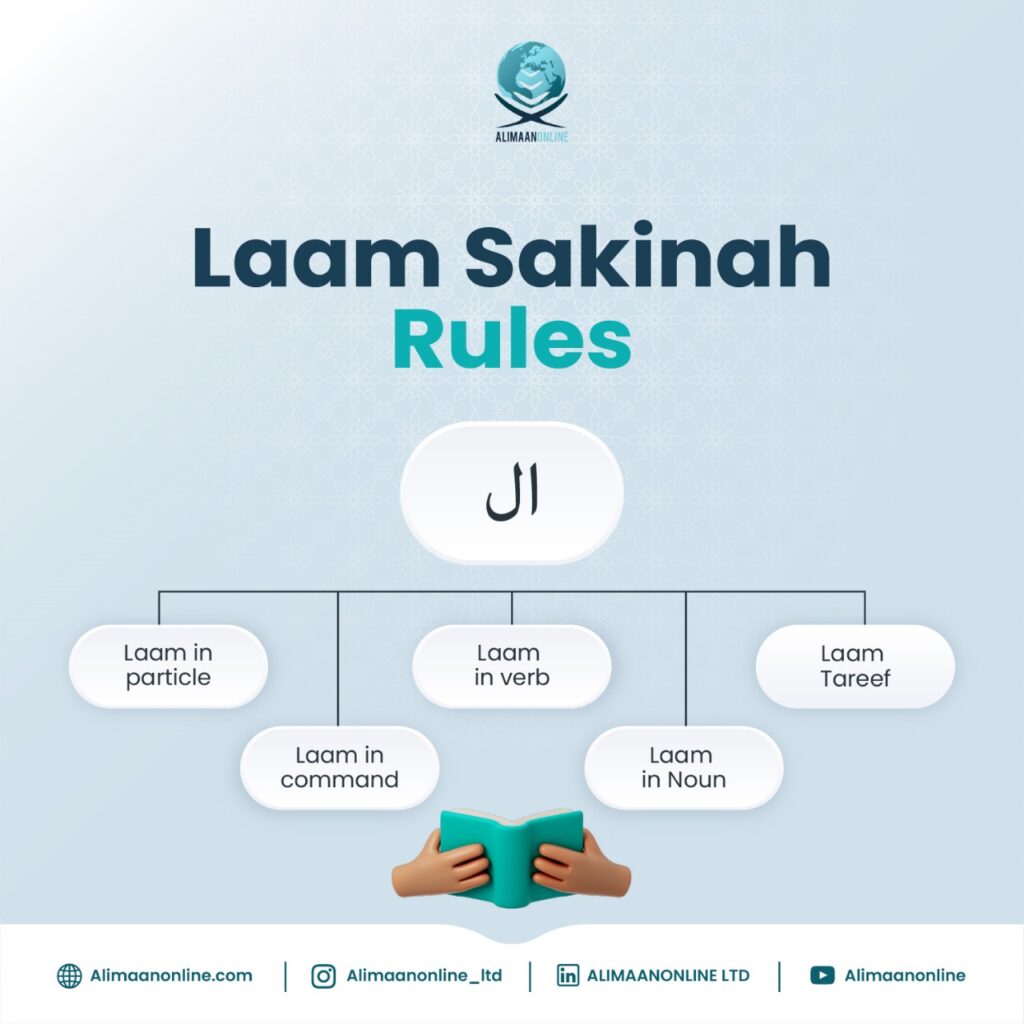Understanding Laam Sakinah Rules is essential for anyone learning the Quran and striving for accurate and beautiful Tajweed pronunciation. These rules govern the pronunciation of the Laam Sakinah, which is a Laam carrying a sukoon, meaning it is read without a vowel. Whether it appears in nouns, verbs, or particles, Laam Sakinah plays a significant role in proper Quranic recitation.
In this guide, we will explore the question, “What Is Laam Sakinah?”, and examine the five Laam Sakinah Rules with examples, including Laam Tareef, Laam in Nouns, Laam in Verbs, Laam in Particles, and Laam in Commanding Verbs. Let’s delve into this important aspect of Tajweed science.
What Is Laam Sakinah?
Before diving into the rules, it’s vital to answer, “What Is Laam Sakinah?” It is the Arabic letter Laam with a sukoon on it, meaning it has no vowel sign. This Laam can appear in the middle or at the end of a word and occurs in various forms in Arabic grammar.
Notably, Laam Sakinah occurs in the Quran frequently and must be recited correctly. If misread, the meaning can change, which is why understanding the Laam Sakinah Rules is fundamental. Now that we’ve defined it, let’s explore how it behaves in different contexts.
Laam Sakinah refers to the letter Laam (ل) when it is in a static (sakin) state, carrying no vowel, and therefore is either merged or clearly pronounced. It often appears within words, as part of phrases, or within the Arabic definite article “Al-” (الـ). Based on the letters following it, Laam Sakinah can follow either the Izhaar (clarity) or Idghaam (merging) rules. Understanding these rules improves the accuracy and fluency of Quran recitation.
Five Laam Sakinah Rules with Examples
After exploring Meem Sakinah and Noon Saakin rules, we now turn our attention to the five key Laam Sakinah rules in the Quran. Each rule depends on whether the Laam appears in a noun, verb, particle, or command verb. These rules operate under two Tajweed principles — Izhaar (clear articulation) and Idghaam (merging without nasal sound).
1. Laam Tareef – The Definite Article Rule
The first and most common rule is Laam Tareef. This refers to the Laam Sakinah that comes at the beginning of definite nouns. In Arabic, this occurs when “Al” (ال) is prefixed to a word, turning it into a definite noun.Depending on the letter following the Laam, it is categorized as either Laam Qamariyya (moon letter) or Laam Shamsiyya (sun letter). This classification determines if we pronounce the Laam or merge it.
There are two sub-rules to remember:
- Idgham (Merging): If the letter following Laam is one of the sun letters (حروف شمسية), the Laam is not pronounced.
- Izhar (Clear Pronunciation): If the letter following Laam is one of the moon letters (حروف قمرية), the Laam is pronounced clearly.
a-Laam Qamariyya (Moon Letters) with Izhaar:
When any of the moon letters follows the Laam Tareef, we apply Izhaar, meaning the Laam is pronounced clearly without merging. These letters include:
هـ, ي, و, م, ك, ق, ف, غ, ع, خ, ح, ج, ب, أ
✅ Examples from the Quran:
ٱلْفَلَقِ (Al-Falaq)
ٱلْفَجْر (Al-Fajr)
ٱلْبَيْت (Al-Bayt)
ٱلْعَرْشِ (Al-Arsh)
ٱلْجِنَّةِ (Al-Jinnah)
b-Laam Shamsiyya (Sun Letters) with Idghaam:
When any of the sun letters follows the Laam, we apply Idghaam. That means the Laam is merged into the following letter without Ghunna.
These letters include:
ن, ل, ظ, ط, ض, ص, ش, س, ز, ر, ذ, د, ت
✅ Examples from the Quran:
- ٱلنَّعِيمِ (An-Na’eem)
- الرُّوحُ (Ar-Rooh)
- التَّغَابُنِ (At-Taghaabun)
- السَّمَاءُ (As-Samaa’)
- الرَّحْمَـٰنُ (Ar-Rahman)
2. Laam Sakin in Noun (Laam Al Ism)
The second rule focuses on the Laam Sakin in Noun (Ism). This type of Laam appears in the middle or end of certain nouns and must be pronounced clearly with Izhaar. This Laam occurs naturally in some Arabic nouns and is not part of the definite article.
Unlike Laam Tareef, which may be merged or silent, this Laam is always pronounced with clarity, regardless of what follows. It is important to articulate it properly to maintain the word’s meaning and grammar.
✅ Examples of nouns with Laam Sakinah:
فُلْكِهِمْ (Fulki-him)
سَلْسَبِيلًا (Salsabeela)
سُلْطَان (Sultaan)
Although these examples may appear simple, missing the sukoon on Laam or mispronouncing it can alter the meaning. Therefore, clear enunciation is necessary.
3. Laam Sakin in Verb (Laam Al Fi’l)
Next, we look at the Laam Sakin in Verb (Fi’l), which refers to the silent Laam in verb forms. This can occur in both the command form and past tense form of certain verbs.
This Laam is pronounced unless a rule of Idgham or elision applies due to Tajweed or grammar rules. These are more advanced cases, but for most learners, pronouncing the Laam is the default rule.
Laam Sakin in verbs appears either in the middle or at the end of a verb form. Depending on the letter that follows, we either apply Izhaar or Idghaam.
✅ When the following letter is not Laam or Raa, we apply Izhaar:
- قُلْ أَنْتُم (Qul Antum) – Here the Laam is pronounced clearly.
✅ If the letter following Laam is Laam or Raa, we apply Idghaam:
- أَقُل لَّكُم (A Qul Lakum) – Laam is merged.
- قُل رَّبِّ (Qul Rabbi) – Laam merges into Raa.
In verbs, proper articulation of the Laam is vital to distinguish between commands and statements. Therefore, Laam Sakin in verbs needs careful study and consistent practice.
4. Laam Sakin in Particle ( Laam Al Harf)
The fourth rule deals with Laam Sakin in Particle (Harf). A particle is a small word that connects or modifies sentences but carries no standalone meaning.
Laam Sakin can appear in such particles and is typically pronounced clearly. This rule is simple but equally important because particles appear frequently in Quranic Arabic and classical texts.
When Laam Sakin occurs at the end of a particle (harf), such as بَل or هَل, the rule depends again on the letter that follows.
✅ If the next letter is Laam or Raa, apply Idghaam:
- هَل لَّكُم (Hal Lakum)
- بَل رَّبِّي (Bal Rabbi)
✅ If the following letter is not Laam or Raa, apply Izhaar:
بَلْ هُمْ (Bal Hum)
هَلْ أَنْتُم (Hal Antum)
Despite being small words, these particles can change the sentence’s tone and meaning. Hence, their Laam Sakin must be pronounced clearly and confidently.
5. Laam Sakin in Commanding Verb
The fifth rule in our list of Laam Sakinah Rules is the Laam Sakin in Commanding Verb. This specifically refers to verbs given in the imperative or command form, where the Laam carries a sukoon.
Just like in the earlier examples, this Laam is pronounced without merging, and doing so incorrectly may distort the command. Correct pronunciation here is essential, especially during recitation and prayer.
This rule appears when Laam Sakin occurs in commanding verbs — often in verbs starting with ي in the present tense, and preceded by ثم، و، or ف.
✅ Examples of commanding verbs with Laam Sakinah:
وَلْيُوفُوا (Walyuufu)
ثُمَّ لْيَقْضُ (Thumma Liyaqdu)
Since many Quranic instructions use commanding verbs, mastering this rule allows students to recite the Quran accurately and understand divine instructions.
Types of Laam in Arabic Grammar
Beyond Laam Sakinah, Laam appears in Arabic grammar in several forms, each with a specific purpose and rule. Understanding these forms enhances your command of Arabic structure.
Laam Al-Jar (لام الجر)
This is the prepositional Laam used to indicate a relationship, like possession or direction. Example: لِلنَّاسِ (for the people).
Laam Al-Tawkeed (لام التوكيد)
This emphasizing Laam is used to confirm or stress a statement. Example: لَيُبْعَثَنَّ (he will surely be resurrected).
Both of these Laams may sometimes carry a Sukoon and can resemble Laam Sakinah in structure but serve grammatical roles beyond pronunciation.
What Is Laam Alif (لا)?
Laam Alif (لا) is a ligature in Arabic script formed by the combination of the letters Laam (ل) and Alif (ا). It is not a distinct letter on its own, but rather a typographical form used for writing convenience and aesthetic appeal, particularly in printed texts and Arabic calligraphy. The shape (لا) is one of the most recognized ligatures in Arabic writing.
Usage in Quranic and Modern Arabic Text
In the Qur’an, Laam Alif appears within certain words—especially the word “لَا” (laa), meaning “no” or “not”. It follows standard Tajweed rules based on its context. For instance:
- لَا إِلَٰهَ إِلَّا ٱللَّهُ
“There is no god but Allah.”
In this phrase, لَا is pronounced clearly with Laam having a Fatḥah and the Alif extending the sound—this is a basic application of Madd Tabee‘i.
Structural, Not Grammatical
It is important to note that Laam Alif serves no independent grammatical function. It is a structural component of words, not a grammatical tool. This distinguishes it from other forms of Laam, like:
- Laam Al-Ta‘reef (لام التعريف): The definite article prefix “Al-” (أل), used to make nouns definite (e.g., الكتاب “the book”).
- Laam Al-Jarr (لام الجر): The prepositional Laam that causes the noun after it to take the genitive case (e.g., لِرَسُولِهِ “for His messenger”).
Key Differences Between Laam Alif and Laam Al-Ta‘reef
| Feature | Laam Alif (لا) | Laam Al-Ta’reef (أل) |
|---|---|---|
| Form | Ligature of Laam + Alif | Laam used as a prefix for definiteness |
| Function | Structural | Grammatical |
| Example | لَا (No) | الشَّمْس (The sun) |
| Tajweed | Pronounced based on position and rules of Madd | Subject to Izhaar or Idghaam depending on the following letter |
Importance of Understanding Laam Sakinah Rules
Now that we’ve covered the five Laam Sakinah Rules with examples, it’s essential to understand their importance. Correct pronunciation ensures that:
- Quranic verses are recited with clarity.
- The meaning of the words remains intact.
- The beauty of Tajweed is preserved.
How to Practice Laam Sakinah Rules Effectively
To master the Laam Sakinah Rules, students can take the following practical steps:
- Listen to Professional Reciters: Focus on their pronunciation of Laam Sakinah in various words.
- Repeat After Listening: Use audio tools to mimic the correct usage of Laam in each case.
- Memorize Common Examples: Knowing typical words that carry Laam Sakinah will help reinforce the rules.
- Take a Tajweed Course: Structured guidance from a teacher will help clarify nuances in application.
- Recite with Feedback: Ask a qualified teacher to listen and correct your pronunciation.
Common Mistakes in Pronouncing Laam Sakinah
When learning Tajweed, beginners often make these mistakes regarding Laam Sakinah:
Applying sun letter rules to moon letters.
Ignoring the Izhar rule in Laam Tareef.
Merging Laam unnecessarily in nouns or verbs.
Skipping Laam in small particles like هل or بل.
Conclusion: Mastering Laam Sakinah Rules
Learning the Laam Sakinah Rules is essential for Tajweed and Arabic fluency. Whether the Laam appears as a part of Laam Tareef, inside a noun, within a verb, in a particle, or in a commanding verb, applying the right rule ensures your recitation is accurate and beautiful.
To summarise:
- Always apply Izhaar unless the next letter is Laam or Raa, which requires Idghaam.
- Laam Tareef has specific rules based on moon or sun letters.
- Understanding the context — noun, verb, or particle — helps in applying rules precisely.

